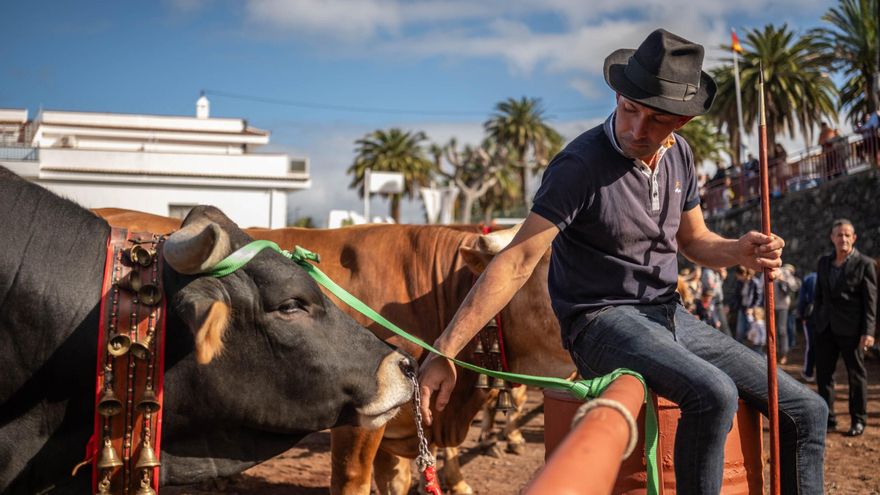
“The cattle farming remains steady, but that does not imply that the industry is thriving. Quite the opposite.” An expert, Theo Hernando, general secretary of the Association of Farmers and Livestock of Canary Islands Asaga, elaborates: “The comparison between 2023 and 2024 reveals a slight increase in both the number of farms and heads in the livestock sector. However, we must examine the decade from 2014 to 2024 to draw any significant conclusions.” The statistics are alarming: one in three farms—one third of the total, which is 466 out of 1,896—has ceased operations due to various factors, including the pandemic’s impact. Conversely, the number of heads, with a positive increase of 16.7% (260,482 when including chickens) and a 27.3% decrease (27,766 when excluding birds), has seen a minor rise. According to Hernando, this indicates that “the larger farms, which have managed to upgrade machinery or implement technological advancements, are the ones that are persevering, leading to a concentration of livestock production. The large farms are expanding.”
Farms
In terms of farms, both Caprino (from 226 to 221) and bovine (from 167 to 164) have slightly decreased over the past year. Nonetheless, a stark decline is evident when comparing the years 2014 and 2024. There are 122 fewer, marking a 36.6% drop, with goats reducing from 343 to 221, and 88 fewer cows (a 34.9% decline) dropping from 252 to 164. The swine population has diminished by 34 (28.8%), fluctuating between 118 and 84 across the past decade, while sheep have decreased by 56 (33.3%), from 168 to 112. In contrast, chicken numbers have only slightly reduced by two, from 141 to 139, equating to 1.4%.
Heads
Theo Hernando clarifies that “the two primary sectors within the livestock heads are the bovine, specifically meat cows, and poultry.” The latter may encounter challenges for further growth (having increased by 25% in the past decade) due to new animal welfare legislation that lowers the number of animals permitted within a farm’s confines. In contrast, the cattle population grew from 4,078 to 5,202, representing a 27.6% increase (1,124 heads). Meanwhile, the poultry sector has expanded by 26.6%, rising from 1,454,465 to 1,641,322, with an increase of 386,857.
Decline
On the other hand, the Caprino sector has seen a significant reduction of 4,000 heads (10%) and pigs have decreased by 2,600 (9.8%). This decline persists despite the former being the subsector with greater potential due to “the finished product market, particularly cheese.” It also alleviates the drawbacks as “it is the subsector with the most generational succession,” which is one of the key issues in Tenerife’s agriculture as a whole and livestock specifically.
Poultry
Overall, the data from 2014 to 2024 fluctuate depending on whether chickens are included. In the first scenario, the livestock sector would grow by 16.7% with 260,482 heads, while in the latter, factoring in the inherent volatility of birds, production would fall by 27.3% overall, with 27,765 fewer examples in 2024 compared to the figures recorded in 2014.
Disappearance
A particularly alarming situation is that of the Cuniculture livestock, representing rabbits. The population has plummeted from 26,293 heads in 2014 to just 4,027 last year, showcasing a staggering reduction of 22,266, equating to an 84.7% drop. However, Hernando notes that in the early 2000s, there were around 200,000 rabbits in the Canary Islands. Tenerife’s influence has slightly diminished at the regional level, dropping from 36.38% in 2014 to 35.01% in 2024, yet it still remains at the forefront. As for bees—“that livestock that flies,” as defined by Hernando—there are no precise figures available for 2024. Approximately 15,000 hives operate under 600 beekeepers, having reduced by 1,251 between 2022 and 2023. Likely, the severe forest fire of 2023 (occurring from August to November) that impacted prime beekeeping regions (higher altitudes) has considerably contributed to this decline.
Significance
The livestock industry in Tenerife serves as a crucial pillar of the island’s economy and culture. With its diverse landscape and rich agricultural traditions, a modest industry has evolved. The sector encompasses various animal types, each playing a distinct role in the local economy. Caprina dominates, as goats are resilient and well-suited to the island’s mountainous terrain, with their milk utilised to create high-quality local cheeses. Sheep also exist, albeit in fewer numbers, primarily for wool and meat production. Bovine farming focuses on supplying milk and meat for the local market, while poultry farming is specialised in the breeding of birds for meat and eggs, primarily catering to island demand.
History
The livestock sector boasts deep-rooted traditions on the island, tracing back to the Guanche era. Early farmers raised goats and sheep for meat, milk, and wool, optimising available natural resources. The arrival of European colonisers in the fifteenth century widened and diversified livestock farming, bringing in new breeds and husbandry methods. Over time, the industry has undergone significant transformations, adapting to shifting economic and environmental conditions. Transitioning from small, family-run farms to large-scale production, livestock farming remains integral to rural life in Tenerife. Presently, efforts must concentrate on all stakeholders to maintain its relevance, even amid a prolonged crisis.















